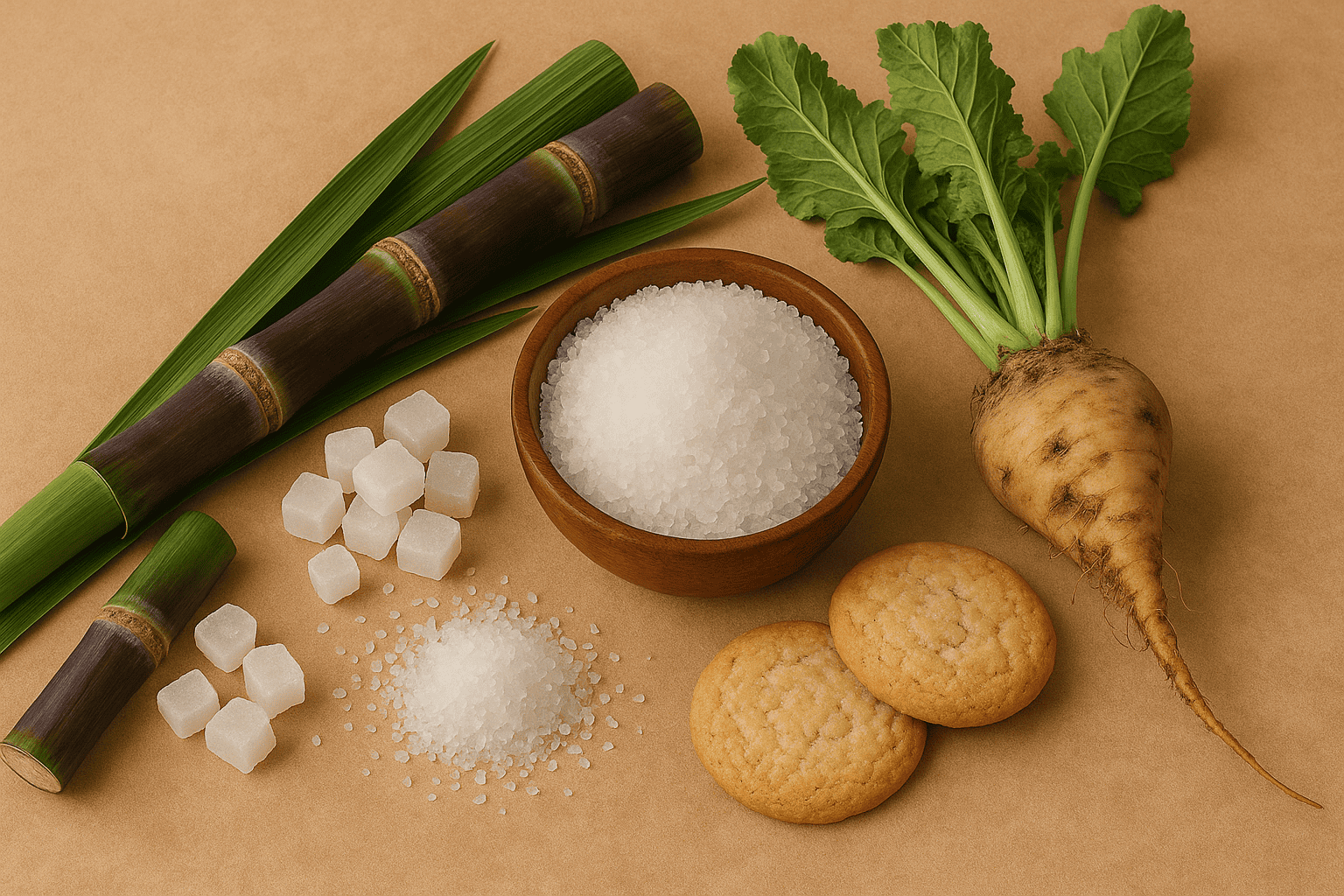Sugar – From the Beginning to Today

Sugar is everywhere today. We stir it into our morning coffee, we find it in cookies and cakes, but also in sodas, sauces, ketchup, and even bread. Although it seems ordinary and indispensable in our diets, its history is fascinating and full of dramatic transformations. Sugar was once more expensive than gold, it triggered wars and colonization, powered empires, changed trade routes, and reshaped human health. At the same time, it raises a simple but intriguing question: what did people do before refined sugar existed, and how did they satisfy their craving for sweetness?
The origins of sugar
The story begins in Southeast Asia, particularly in India. More than two thousand years ago, people learned how to crush sugarcane stalks and boil the juice, producing sweet crystals. This was the first crystallized sugar in history. The Sanskrit word śarkarā, meaning crystal, gave rise to today’s words sugar, sucre, zucchero, and zahăr.
Knowledge spread to Persia, and later to the Arab world, where sugar production was refined and improved. Arabs were masters of agriculture and commerce, and they brought sugarcane to North Africa and Southern Europe, planting the seeds of an ingredient that would later conquer the world.
Foreigner In Romania and in need of a prescription for your chronic treatment?
Contact Dr. Petrache’s Virtual Clinic for any medical issue you encounter while in Romania. Send an email to: clinica@diabet-si-nutritie.ro
Sugar in Antiquity and the Middle Ages
For the Greeks and Romans, sweetness came from honey. Sugar was so rare that when it did arrive, it was treated as a curiosity from distant lands. Pliny the Elder, in the 1st century AD, wrote: “Sugar is a kind of solid honey imported from India.”
During the Middle Ages, sugar was sold in pharmacies, prescribed as medicine for digestive problems, melancholy, and weakness. In aristocratic courts, it was a symbol of luxury. Royal feasts often featured elaborate sugar sculptures and sweet delicacies, while ordinary people could hardly imagine its taste.
Sugar and the Age of Exploration
The 15th and 16th centuries brought radical change. Portuguese sailors brought sugarcane to Madeira and then to Brazil, while Spaniards introduced it to Cuba and the Dominican Republic. The tropical climate was perfect for large plantations, and Europe’s appetite for sugar grew quickly.
Thus, sugar became the center of the infamous “triangular trade.” European ships carried goods to Africa, traded them for slaves, transported enslaved people to the Americas, and returned with sugar and other colonial goods. Sugar was so valuable it was called “white gold.”
At the same time, sugar fueled the popularity of other exotic products: tea, coffee, and chocolate. Without sugar, these bitter drinks might never have conquered European taste.
The beet sugar revolution
In the 18th century, German chemist Andreas Marggraf discovered that sugar crystals could also be extracted from beets. This discovery would reshape European agriculture. Napoleon Bonaparte strongly supported beet cultivation in France to reduce dependence on British-controlled colonies.
From then on, sugar was no longer a luxury. It entered the diets of all social classes, and with industrialization in the 19th century, factories produced massive amounts of refined sugar. Cookies, cakes, and candies became everyday treats rather than rare celebrations.
Passing through Romania and need a prescription for your chronic treatment?
Contact Dr. Petrache’s Virtual Clinic for any medical issue you encounter while in Romania. Send an email to: clinica@diabet-si-nutritie.ro
Sugar in the modern era
The 20th century turned sugar into the backbone of the processed food industry. Sodas, chocolate bars, packaged pastries, jams, and countless other products relied on abundant and cheap sugar. But sugar also appeared where no one expected it: bread, sauces, yogurts, and processed meats.
This omnipresence led to skyrocketing consumption. While a medieval person consumed just a few hundred grams per year, the average modern person in many countries consumes 30–40 kilograms annually.
Sugar and health
With abundance came consequences. Excess sugar intake is now linked to obesity, type 2 diabetes, cardiovascular disease, tooth decay, and even certain cancers. The World Health Organization recommends limiting added sugars to less than 10% of daily energy intake, ideally under 5%. Yet in reality, most people far exceed these recommendations.
What did people do before sugar?
Humans have always had a natural attraction to sweetness. It signals safe energy sources. But without refined sugar, how did our ancestors meet this need?
The answer lies in honey, the golden treasure of antiquity. Egyptians saw it as a divine gift, Greeks called it the “nectar of the gods,” and Romans used it in wines, sauces, and desserts. Honey was food, medicine, and even part of religious rituals.
Fruits were another source. Dates, figs, grapes, apples, and berries were consumed fresh or dried. Drying concentrated their sugars, turning raisins and dried figs into the “candies” of the ancient world.
Other natural sweeteners included maple syrup in North America and licorice root, chewed for its sweet flavor. Sweetness existed, but it was seasonal, rare, and natural. That rarity made it precious, unlike today when sugar is always within reach.
Sugar and culture
Sugar reshaped culinary traditions around the globe. French patisserie, with its delicate macarons and tarts, flourished thanks to sugar. In Victorian England, tea with biscuits became a daily ritual. Across Europe, Christmas and Easter desserts became richer and sweeter. In Asia, rice puddings and syrupy sweets marked festivals and family celebrations.
Cultural identity is often expressed through sweet traditions, and sugar is at the heart of many of them.
Sugar and psychology
Sugar stimulates the brain’s reward system, releasing dopamine and creating a sense of pleasure. This survival mechanism once helped humans seek nutritious foods, but today it fuels overconsumption and even addictive behaviors. The modern food environment, saturated with sugar, exploits this ancient instinct.
Tourist in Romania and in need of a prescription for your chronic treatment?
Contact Dr. Petrache’s Virtual Clinic for any medical issue you encounter while in Romania. Send an email to: clinica@diabet-si-nutritie.ro
Conclusion
The story of sugar is the story of humanity itself: from rare crystals in ancient India to royal feasts, from colonial plantations to supermarket shelves, from medicine to excess. Sugar shaped trade, empires, and traditions, and it still shapes our health and culture today.
Before refined sugar, people satisfied their sweet cravings with honey, fruits, and natural syrups. They consumed sweetness rarely, in balance with nature. Today, perhaps the lesson is to rediscover that balance: to see sweetness as a rare joy, not a daily habit.
Sugar is not an enemy, but it is a powerful force. Moderation, awareness, and a return to natural sources can help us enjoy it without falling victim to its excess.
Follow us on:
- FaceBook: Diabetes & Nutrition;
- YouTube: Diabetes Facts.
















